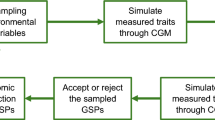Abstract
For the improvement of genetic material suitable for on farm use under low-input conditions, participatory and formal plant breeding strategies are frequently presented as competing options. A common frame of reference to phrase mechanisms and purposes related to breeding strategies will facilitate clearer descriptions of similarities and differences between participatory plant breeding and formal plant breeding. In this paper an attempt is made to develop such a common framework by means of a statistically inspired language that acknowledges the importance of both on farm trials and research centre trials as sources of information for on farm genetic improvement. Key concepts are the genetic correlation between environments, and the heterogeneity of phenotypic and genetic variance over environments. Classic selection response theory is taken as the starting point for the comparison of selection trials (on farm and research centre) with respect to the expected genetic improvement in a target environment (low-input farms). The variance-covariance parameters that form the input for selection response comparisons traditionally come from a mixed model fit to multi-environment trial data. In this paper we propose a recently developed class of mixed models, namely multiplicative mixed models, also called factor-analytic models, for modelling genetic variances and covariances (correlations). Mixed multiplicative models allow genetic variances and covariances to be dependent on quantitative descriptors of the environment, and confer a high flexibility in the choice of variance-covariance structure, without requiring the estimation of a prohibitively high number of parameters. As a result detailed considerations regarding selection response comparisons are facilitated. The statistical machinery involved is illustrated on an example data set consisting of barley trials from the International Center for Agricultural Research in the Dry Areas (ICARDA). Analysis of the example data showed that participatory plant breeding and formal plant breeding are better interpreted as providing complementary rather than competing information.
Similar content being viewed by others
References
Atlin, G.N., M. Cooper, A. Bjørnstad & F.A. van Eeuwijk,2001. A comparison of formal andparticipatory breeding approaches using selection theory.Euphytica: This Volume.
Bänziger, M. & M. Cooper,2001.Breeding for low-input conditions and consequences for participatory plant breeding - Examples from tropical maize and wheat.Euphytica: This Volume.
Ceccarelli, S., 1996. Positive interpretation of genotype by environment interactionsin relation to sustainability and biodiversity. In: M. Cooper & G.L. Hammer (Eds.), Plant Adaptation and Crop Improvement, pp. 467–486. CAB International, Wallingford, England.
Ceccarelli, S., S. Grando, R. Tutwiler, J. Baha, A.M. Martini, H. Salahieh, A. Goodchild & M. Michael,2000.A methodological study on participatory barley breeding. I. Selection phase. Euphytica 111:91–104.
Chapman, S.C., M. Cooper, D. Butler & R.G. Henzell,2000a. Genotype by environment interactions affecting grain sorghum. I. Characteristics that confound interpretation of hybrid yield. Austr J Agric Res51: 197–207.
Chapman, S.C., M. Cooper, G.L. Hammer & D. Butler,2000b.Genotype by environment interactions affecting grain sorghum. II. Frequencies of different seasonal patterns of drought stress are related to location effects on hybrid yields.Austr J Agric Res51: 209–221.
Chapman, S.C., G.L. Hammer, D.G. Butler & M. Cooper,2000c. Genotype by environment interactions affecting grain sorghum. III. Temporal sequences and spatial patterns in the target population of environments.Austr J Agric Res51:223–233.
Cooper, M.,R.E. Stucker, I.H. DeLacy & B.D. Harch,1997. Wheat breeding nurseries, target environments, and indirect selection for grain yield.Crop Sci 37: 1168–1176.
Cooper, M., & I.H. DeLacy,1994.Relationships amonganalytical methods used to study genotypic variation and genotype-byenvironment interaction in plant breeding multi-environment experiments.Theor Appl Genet88:561–572.
Cullis, B.S. & A.C. Gleeson, 1991.Spatial analysis of fieldexperiments - An extension to two dimensions.Biometrics47: 1449–1460.
Cullis, B.S., S.J. Welham, R. Thompson & A.R. Gilmour, 1998. New Developments in REML and its Implementation in Genstat 5 Release 4.1. Orange Agricultural lnstitute, Orange, NSW2800, Australia.
DeLacy, I.H., K.E. Basford, M. Cooper, J.K. Buil & C.G. McLaren, 1996. Analysis of multi-environment trials - An historical perspective. In: M. Cooper & G.L. Hammer (Eds.), Plant Adaptation and Crop lmprovement, pp.39–124.CAB International, Wallingford, England.
Denis, J.B., H.P. Piepho & F.A. van Eeuwijk,1997.Modelling expectation and variance for genotype by environmentdata. Heredity79: 162–171.
Eyzaguirre, P. & M. Iwanaga,1996.Participatory Plant Breeding. ProcWorkshop on Participatory Plant Breeding, 26–29 July 1995, Wageningen, Netherlands. IPGRI, Rome, Italy.
Gabriel, K.R.,1971. The biplot graphic display of matrices with applications to principal components analysis.Biometrika 58: 453–467.
Gower, J.C. & D.J. Hand, 1996. Biplots. Chapman and Hall, London.
Falconer, D.S.,1981.Introduction to quantitative genetics,2nd edn. Longman, London.
Gilmour, A.R., R. Thompson & B.R. Cullis,1995. Average information REML: An efficient algorithm for variance parameter estimation in linear mixed models. Biometrics 51:1440–1450.
Gogel, B.J., B.R. Cullis & A.P. Verbyla, 1995.REML estimationof multiplicative effects in multi-environment variety trials. Biometrics51:744–449.
Joshi, A. & J.R. Witcombe, 1996. Farmer participatory crop improvement. II. Participatory varietal selection, a case study in India.Experimental-Agriculture32(4):461–477.
Kempton, RA., 1984.The use of biplots in interpretingvariety by environment interactions.J Agric Sci Cambridge103:123–135.
Longford, N.T., 1993.RandomCoefficient Models.Clarendon Press, Oxford.
McCullagh, P. & J.A. Nelder,1989. Generalized linearmodels,2nd edn. Chapman and Hall, London.
Neter, J., M.H. Kutner, C.J. Nachtsheim & W. Wasserman,1996. Applied linear statistical models,4th edn.Irwin, Chicago.
Oman, S.D.,1991.Multiplicative effects in mixed model analysis of variance.Biometrika78:729–739.
Piepho, H.-P.,1997. Analyzing genotype-environment data by mixed models with multiplicative terms.Biometrics53:761–766.
Piepho, H.-P., J.-B. Denis & F.A. van Eeuwijk,1998.Mixed biadditive models. In: Proc 19th Int BiometricConf, Capetown, pp. 79–89.
Piepho, H.-P. & F.A. van Eeuwijk,2001.Stability analysis in crop performanceevaluation. In: M.S. Kang (Ed.), Crop Improvement, Challenges in the 21st Century, Chpt II. Haworth Press, New York.
SAS Institute,1997. SAS/STAT Software: Changes and Enhancements through Release 6.12.SASInstitute, Cary, NC.
Smith, A.B., 1999.Multiplicative Mixed Models for the Analysis of Multi-Environment Trial Data.Ph.D. Thesis Dpt of Statistics, The University of Adelaide, Adelaide, South Australia, 5005, Australia.
Stram, D.O. & J.W. Lee,1994. Variance components testing in the longitudinal mixed effects setting.Biometrics50:1171–1177.
Tinker, N.A., D.E. Mather, B.G. Rossnagel, K.J. Kasha, A. Kleinhofs, P.M. Hayes, D.E. Falk, T. Ferguson, L.P. Shugar, W.G. Legge, R.B. Irvine, T.M. Choo, K.G. Briggs, S.E. Ullrich, J.D. Franckowiak, T.K. Blake, R.J. Graf, S.M. Dofing, M.A. Saghai Maroof, G.J. Scoles, D. Hoffman, L.S. Dahleen, A. Kilian, F. Chen, R.M. Biyashev, D.A. Kudrna & B.J. Steffenson, 1996. Regions of the genome that affect agronomic performance in two-row barley.Crop Sci36:1053–1062.
van Eeuwijk, F.A., 1995. Linear and bilinear models for the analysis ofmulti-environment trials: I. An inventory of models.Euphytica 84:1–7.
Author information
Authors and Affiliations
Rights and permissions
About this article
Cite this article
van Eeuwijk, F., Cooper, M., DeLacy, I. et al. Some vocabulary and grammar for the analysis of multi-environment trials, as applied to the analysis of FPB and PPB trials. Euphytica 122, 477–490 (2001). https://doi.org/10.1023/A:1017591407285
Issue Date:
DOI: https://doi.org/10.1023/A:1017591407285




